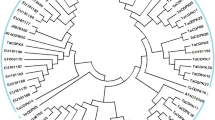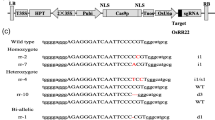Abstract
Salicornia brachiata is one of the extreme salt tolerant plants and grows luxuriantly in coastal areas. Previously we have reported isolation and characterization of ESTs from S. brachiata with large number of unknown gene sequences. Reverse Northern analysis showed upregulation and downregulation of few unknown genes in response to salinity. Some of these unknown genes were made full length and their functional analysis is being tested. In this study, we have selected a novel unknown salt inducible gene SbSI-1 (Salicornia brachiata salt inducible-1) for the functional validation. The SbSI-1 (Gen-Bank accession number JF 965339) was made full length and characterized in detail for its functional validation under desiccation and salinity. The SbSI-1 gene is 917 bp long, and contained 437 bp 3′ UTR, and 480 bp ORF region encoding 159 amino acids protein with estimated molecular mass of 18.39 kDa and pI 8.58. The real time PCR analysis revealed high transcript expression in salt, desiccation, cold and heat stresses. However, the maximum expression was obtained by desiccation. The ORF region of SbSI-1 was cloned in pET28a vector and transformed in BL21 (DE3) E. coli cells. The SbSI-1 recombinant E. coli cells showed tolerance to desiccation and salinity stress compared to only vector in the presence of stress.




Similar content being viewed by others
References
Agarwal PK, Jha B (2010) Transcription factors in plants and ABA dependent and independent abiotic stress signalling. Biol plant 54:201–212
Seki M, Narusaka M, Ishida J, Nanjo T, Fujita M, Oono Y, Kamiya A, Nakajima M, Enju A, Sakurai T, Satou M, Akiyama K, Taji T, Yamaguchi-Shinozaki K, Carninci P, Kawai J, Hayashizaki Y, Shinozaki K (2002) Monitoring the expression profiles of 7000 Arabidopsis genes under drought, cold and high-salinity stresses using a full-length cDNA microarray. Plant J 31:279–292
Umezawa T, Fujita M, Fujita Y, Yamaguchi-Shinozaki K, Shinozaki K (2006) Engineering drought tolerance in plants: discovering and tailoring genes unlock the future. Curr Opin Biotechnol 17:113–122
Ashraf M, Akram NA (2009) Improving salinity tolerance of plants through conventional breeding and genetic engineering: an analytical comparison. Biotechnol Adv 27:744–752
Vinocur B, Altman A (2005) Recent advances in engineering plant tolerance to abiotic stress: achievements and limitations. Curr Opin Biotechnol 16:123–132
Amtmann A, Bohnert HJ, Bressan RA (2005) Abiotic stress and plant genome evolution: search for new models. Plant Physiol 138:127–130
Zhang L, Xiu-Ling Ma, Zhang Q, Chang-Le Ma, Wang PP, Sun YF, Zhao YX, Zhang H (2001) Expressed sequence tags from a NaCl-treated Suaeda salsa cDNA library. Gene 267:193–200
Kore-eda S, Cushman MA, Akselrod I, Bufford D, Fredrickson M, Clark E (2004) Transcript profiling of salinity stress responses by large-scale expressed sequence tag analysis in Mesembryanthemum crystallinum. Gene 341:83–92
Wang ZL, Li PH, Fredricksen M, Gong ZZ, Kim CS, Zhang C, Bohnert HJ, Zhu JK, Bressan RA, Hasegawa PM, Zhao YX, Zhang H (2004) Expressed sequence tags from Thellungiella halophila, a new model to study plant salt-tolerance. Plant Sci 166:609–616
Mehta PA, Sivaprakash K, Parani M, Venkataraman G, Parida AK (2005) Generation and analysis of expressed sequence tags from the salt-tolerant mangrove species Avicennia marina (Forsk) Vierh. Theor Appl Genet 110:416–424
Chen SH, Guo SL, Wang ZL, Zhao JQ, Zhao YX, Zhang H (2007) Expressed sequence tags from the halophyte Limonium sinense. J Seq Map 18:61–67
Zouri N, Ben Saad R, Legavre T, Azaza J, Sabau X, Jaoua M, Masmoudi K, Hassairi A (2007) Identification and sequencing of ESTs from the halophyte grass Aeluropus littoralis. Gene 404:61–69
Baisakh N, Subudhi PK, Varadwaj P (2008) Primary responses to salt stress in halophyte, smooth cordgrass (Spartina alterniflora Loisel.). Funct Int Gene 8:287–300
Reddy PCO, Sairanganayakulu G, Thippeswamy M, Reddy PS, Reddy MK, Sudhakar C (2008) Identification of stress induced genes from the drought tolerant semi-arid legume crop horsegram (Macrotyloma uniflorum (Lam.) Verdc.) through analysis of subtracted expressed sequence tags. Plant Sci 175:372–384
Jha B, Agarwal PK, Reddy PS, Lal S, Sopory SK, Reddy MK (2009) Identification of salt-induced genes from Salicornia brachiata, an extreme halophyte through expressed sequence tags analysis. Genes Genet Syst 84:111–120
Li HY, Wang YC, Jiang J, Liu GF, Gao CQ, Yang CP (2009) Identification of genes responsive to salt stress on Tamarix hispida roots. Gene 433(1–2):65–71
Jin H, Sun Y, Yang Q, Chao Y, Kang J, Jin H, Li Y, Margaret G (2010) Screening of genes induced by salt stress from Alfalfa. Mol Biol Rep 37:745–753
Gu L, Xu D, You T, Li X, Yao S, Chen S, Zhao J, Lan H, Zhang F (2011) Analysis of gene expression by ESTs from suppression subtractive hybridization library in Chenopodium album L. under salt stress. Mol Biol Rep. doi:10.1007/s11033-011-0678-5
Jha B, Sharma A, Mishra A (2010) Expression of SbGSTU (tau class glutathione S-transferase) gene isolated from Salicornia brachiata in tobacco for salt tolerance. Mol Biol Rep. doi:10.1007/s11033-010-0625-x
Agarwal PK, Gupta K, Jha B (2010) Molecular characterization of the Salicornia brachiata SbMAPKK gene and its expression by abiotic stress. Mol Biol Rep 37:981–986
Jha A, Joshi M, Yadav NS, Agarwal PK, Jha B (2010) Cloning and characterization of the Salicornia brachiata Na+/H+ antiporter gene SbNHX1 and its expression by abiotic stress. Mol Biol Rep. doi:10.1007/s11033-010-0318-5
Murashige T, Skoog F (1962) A revised medium for rapid growth and bioassay with tobacco tissue cultures. Physiol Plant 15:473–497
Chomczynski P, Sacchi N (1987) Single-step method of RNA isolation by acid guanidinium thiocyanate–phenol–chloroform extraction. Anal Biochem 162:156–159
Horton P, Park KJ, Obayashi T, Fujita N, Harada H, Adams-Collier CJ, Nakai K (2007) WoLF PSORT: protein localization predictor. Nucleic Acids Res. doi:10.1093/nar/gkm259
Livak KJ, Schmittgen TD (2001) Analysis of relative gene expression data using real-time quantitative PCR and the 2(-Delta Delta C(T)) method. Methods 25:402–408
Jones AL, Hulett MD, Christopher R, Parish CR (2005) Histidine-rich glycoprotein: a novel adaptor protein in plasma that modulates the immune, vascular and coagulation systems. Immunol Cell Biol 83:106–118. doi:10.1111/j.1440-1711.2005.01320.x
Gupta K, Agarwal PK, Reddy MK, Jha B (2010) SbDREB2A, an A-2 type DREB transcription factor from extreme halophyte Salicornia brachiata confers abiotic stress tolerance in Escherichia coli. Plant Cell Rep 29:1131–1137
Hong GX, Jiang J, Wang BC, Li HY, Wang YC, Yang CP, Liu GF (2010) ThPOD3, a truncated polypeptide from Tamarix hispida, conferred drought tolerance in Escherichia coli. Mol Biol Rep 37:1183–1190
Chaurasia N, Mishra Y, Rai LC (2008) Cloning expression, analysis of phytochelatin synthase (pcs) gene from Anabaena sp. PCC 7120 offering multiple stress tolerance in Escherichia coli. Biochem Biophys Res Commun 376:225–230
Liu Y, Zheng Y (2005) PM2, a group 3 LEA protein from soybean, and its 22-mer repeating region confer salt tolerance in Escherichia coli. Biochem Biophys Res Commun 31:325–332
Reddy PS, Mallikarjuna G, Kaul T, Chakradhar T, Mishra RN, Sopory SK, Reddy MK (2010) Molecular cloning and characterization of gene encoding for cytoplasmic Hsc70 from Pennisetum glaucum may play a protective role against abiotic stresses. Mol Genet Genomics 283:243–254
Acknowledgments
The financial support received from CSIR, New Delhi (NWP-0020) is thankfully acknowledged. The authors are also thankful to Professor Sudhir K. Sopory, ICGEB, New Delhi for his valuable suggestions.
Author information
Authors and Affiliations
Corresponding author
Electronic supplementary material
Below is the link to the electronic supplementary material.
Rights and permissions
About this article
Cite this article
Yadav, N.S., Rashmi, D., Singh, D. et al. A novel salt-inducible gene SbSI-1 from Salicornia brachiata confers salt and desiccation tolerance in E. coli . Mol Biol Rep 39, 1943–1948 (2012). https://doi.org/10.1007/s11033-011-0941-9
Received:
Accepted:
Published:
Issue Date:
DOI: https://doi.org/10.1007/s11033-011-0941-9




